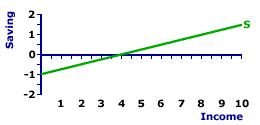
|
|
LAFFER CURVE: The graphical inverted-U relation between tax rates and total tax collections by government. Developed by economist Arthur Laffer, the Laffer curve formed a key theoretical foundation for supply-side economics of President Reagan during the 1980s. It is based on the notion that government collects zero revenue if the tax rate is 0% and if the tax rate is 100%. At a 100% tax rate no one has the incentive to work, produce, and earn income, so there is no income to tax. As such, the optimum tax rate, in which government revenue is maximized, lies somewhere between 0% and 100%. This generates a curve shaped like and inverted U, rising from zero to a peak, then falling back to zero. If the economy is operating to the right of the peak, then government revenue can be increased by decreasing the tax rate. This was used to justify supply-side economic policies during the Reagan Administration, especially the Economic Recovery Tax Act of 1981 (Kemp-Roth Act).
Visit the GLOSS*arama
|
|


|

|
                           SLOPE, SAVING LINE: The positive slope of the saving line is also termed the marginal propensity to save (MPS). This slope is greater than zero but less than one, reflecting induced saving and the Keynesian psychological law of consumer behavior that saving increases by less than the increase in income. The slope of the saving line provides the foundation for the slope of the leakages line used in the injections-leakages model. It thus also affects the magnitude of the multiplier process. | Saving Line | 
|
The saving line, also termed propensity-to-save line or saving function, shows the relation between saving and income for the household sector. The income measure commonly used is national income or disposable income. Occasionally a measure of aggregate production, such as gross domestic product, is used instead.A representative saving line is presented in the exhibit to the right. This green line, labeled S in the exhibit, is positively sloped, indicating that greater levels of income generate greater saving by the household sector. This positive relation corresponds to the fundamental psychological law of Keynesian economics. The saving line graphically illustrates the saving-income relation for the household sector, which is the foundation of the leakages line used in Keynesian economics to identify equilibrium income and production. The slope of the saving line presented here is positive, but less than one. In fact, the slope of the saving line is numerically equal to the marginal propensity to save. In this case the slope is equal to 0.25. The positive slope reflects induced saving--more income means more saving. It also reflects the basic Keynesian psychological law. Click the [Slope] button to illustrate. To illustrate the equality between slope and the marginal propensity to save, consider the equations for each. The slope of the saving line is specified as the "rise" over the "run." The rise is the change in saving measured on the vertical axis and the run is the change in income measured on the horizontal axis. | slope | = | rise
run | = | change in saving
change in income |
The marginal propensity to save (MPS) is the incremental change in saving resulting from an incremental change in income. | MPS | = | change in saving
change in income |
The slope of the saving line is the marginal propensity to save, they are one and the same.The positive slope of the saving line reflects induced saving, which is saving that depends on the level of household sector income. If the household sector receives more income, then it is induced to undertake additional saving. Of course, a drop in income induces the household sector to reduce saving.

Recommended Citation:SLOPE, SAVING LINE, AmosWEB Encyclonomic WEB*pedia, http://www.AmosWEB.com, AmosWEB LLC, 2000-2024. [Accessed: April 29, 2024].
Check Out These Related Terms... | | | | | | | | | | | | | | |
Or For A Little Background... | | | | | | | | | |
And For Further Study... | | | | | | | | | | | | | | | |
Search Again?
Back to the WEB*pedia
|



|

|
WHITE GULLIBON
[What's This?]
Today, you are likely to spend a great deal of time wandering around the shopping mall looking to buy either a wall poster commemorating the moon landing or storage boxes for your winter clothes. Be on the lookout for a thesaurus filled with typos.
Your Complete Scope
This isn't me! What am I?
|

|
|
Junk bonds are so called because they have a better than 50% chance of default, carrying a Standard & Poor's rating of CC or lower.
|

|
|
"Something in human nature causes us to start slacking off at our moment of greatest accomplishment. As you become successful, you will need a great deal of self-discipline not to lose your sense of balance, humility and commitment." -- H. Ross Perot
|

|
NIFO
Next In First Out
|

|
|
Tell us what you think about AmosWEB. Like what you see? Have suggestions for improvements? Let us know. Click the User Feedback link.
User Feedback
|


|


